Report on Business Environment, Organizations, and Structures
VerifiedAdded on 2021/02/21
|11
|2882
|29
Report
AI Summary
This report analyzes the business environment, focusing on three types of organizations: private, public, and voluntary. It examines the characteristics, legal structures (sole trader, partnership, corporation, central, state, local, trust, unincorporated associations), and purposes of each. The report uses Asda, BBC, and NCVO as case studies, comparing their visions, missions, sizes, scopes, and stakeholders. It further explores the interrelationship between different organizational functions (HR, Finance, Marketing, Sales, IT, R&D) and their links to organizational structures (matrix, divisional, flat). The report also highlights the advantages and disadvantages of these interrelationships, providing a comprehensive overview of business organization dynamics. The report also covers PESTLE and SWOT analysis of organizations.
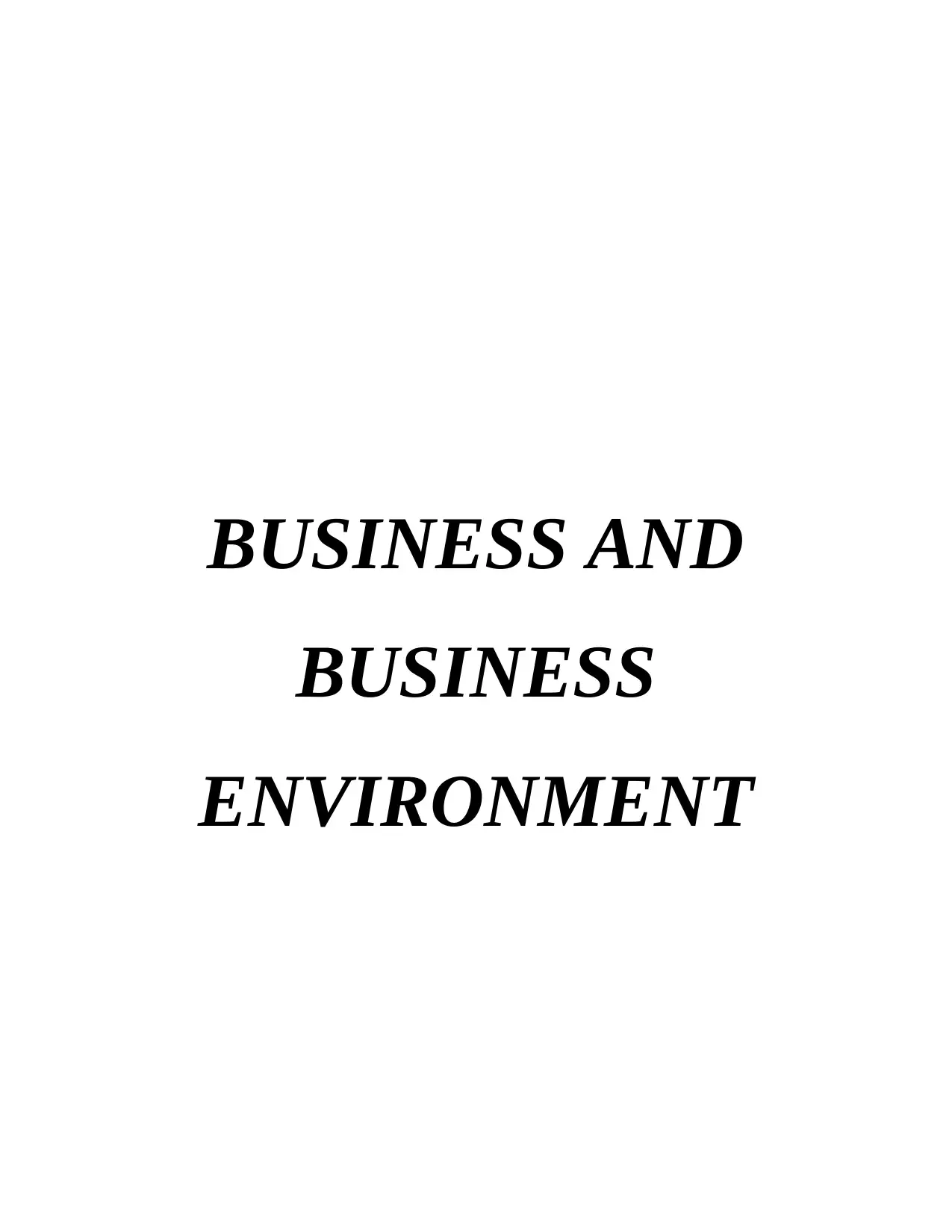
BUSINESS AND
BUSINESS
ENVIRONMENT
BUSINESS
ENVIRONMENT
Paraphrase This Document
Need a fresh take? Get an instant paraphrase of this document with our AI Paraphraser
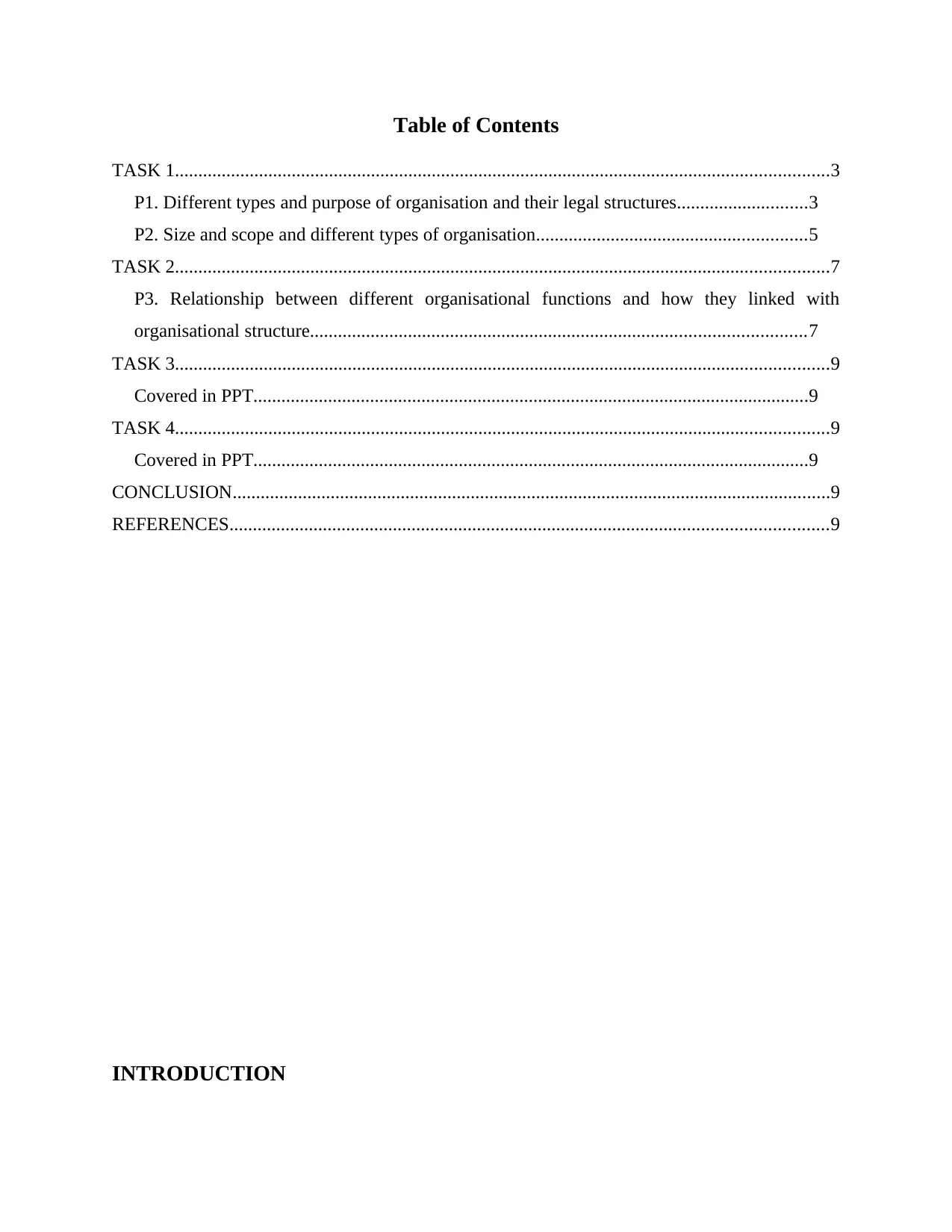
Table of Contents
TASK 1............................................................................................................................................3
P1. Different types and purpose of organisation and their legal structures............................3
P2. Size and scope and different types of organisation..........................................................5
TASK 2............................................................................................................................................7
P3. Relationship between different organisational functions and how they linked with
organisational structure..........................................................................................................7
TASK 3............................................................................................................................................9
Covered in PPT.......................................................................................................................9
TASK 4............................................................................................................................................9
Covered in PPT.......................................................................................................................9
CONCLUSION................................................................................................................................9
REFERENCES................................................................................................................................9
INTRODUCTION
TASK 1............................................................................................................................................3
P1. Different types and purpose of organisation and their legal structures............................3
P2. Size and scope and different types of organisation..........................................................5
TASK 2............................................................................................................................................7
P3. Relationship between different organisational functions and how they linked with
organisational structure..........................................................................................................7
TASK 3............................................................................................................................................9
Covered in PPT.......................................................................................................................9
TASK 4............................................................................................................................................9
Covered in PPT.......................................................................................................................9
CONCLUSION................................................................................................................................9
REFERENCES................................................................................................................................9
INTRODUCTION

Business Environment is an accumulation of internal and external factors which affect the
functions of company either directly or indirectly (Virglerová, Dobeš and Vojtovič, 2016). These
factors include employees, customers, suppliers, customers and many more. It also helps in
identifying the various business opportunities, performance, growth and sustainability. As
business environment is dynamic so all the organisations need to aware about the changes takes
place and also prepare themselves to deal with themselves. This report is in the context of three
business organisations which is private, public and voluntary. Asda is a British supermarket
which deals in groceries, home ware etc. headquarter in Leeds, West Yorkshire. This report
cover various types of business organisations with their legal structures and their size and scope.
It also discuss the interrelationship of different organisational functions. It also conduct PESTLE
and SWOT analysis of organisations.
TASK 1
P1. Different types and purpose of organisation and their legal structures
There are different types of organisations who gather in an environment in order to
achieve their goals. These organisations are classified into 3 categories:
Private organisation: These are the organisations who runs by a single person in order to
maximise or earn profit. These individuals raise their funds by themselves and lend large number
of share in the development of economy (Schaltegger, Hansen and Lüdeke-Freund, 2016).
Moreover, as they are private organisations they have their own rules and regulations but apart
from this they need to follow some government norms which abide them. For instance, Asda is a
supermarket company and a second largest supermarket chain in a Britain. Company follow
various norms which are established by UK government as it is helpful for them in order to
operate in the business environment.
Purpose: Their aim is to earn more and more profit to survive for longer period of time,
maintain transparency in the company and among employees and select an appropriate structure
for them to operate. Their legal structures are classified into 3 categories: Sole trader: It is operated by an individual in which there is no legal differentiation
among the proprietor and business entity. A sole trader has various responsibilities of the
entity such as profits, losses, debts and many more (Prajogo, 2016). It is the easiest form
of business because it does not involves lot of paperwork.
functions of company either directly or indirectly (Virglerová, Dobeš and Vojtovič, 2016). These
factors include employees, customers, suppliers, customers and many more. It also helps in
identifying the various business opportunities, performance, growth and sustainability. As
business environment is dynamic so all the organisations need to aware about the changes takes
place and also prepare themselves to deal with themselves. This report is in the context of three
business organisations which is private, public and voluntary. Asda is a British supermarket
which deals in groceries, home ware etc. headquarter in Leeds, West Yorkshire. This report
cover various types of business organisations with their legal structures and their size and scope.
It also discuss the interrelationship of different organisational functions. It also conduct PESTLE
and SWOT analysis of organisations.
TASK 1
P1. Different types and purpose of organisation and their legal structures
There are different types of organisations who gather in an environment in order to
achieve their goals. These organisations are classified into 3 categories:
Private organisation: These are the organisations who runs by a single person in order to
maximise or earn profit. These individuals raise their funds by themselves and lend large number
of share in the development of economy (Schaltegger, Hansen and Lüdeke-Freund, 2016).
Moreover, as they are private organisations they have their own rules and regulations but apart
from this they need to follow some government norms which abide them. For instance, Asda is a
supermarket company and a second largest supermarket chain in a Britain. Company follow
various norms which are established by UK government as it is helpful for them in order to
operate in the business environment.
Purpose: Their aim is to earn more and more profit to survive for longer period of time,
maintain transparency in the company and among employees and select an appropriate structure
for them to operate. Their legal structures are classified into 3 categories: Sole trader: It is operated by an individual in which there is no legal differentiation
among the proprietor and business entity. A sole trader has various responsibilities of the
entity such as profits, losses, debts and many more (Prajogo, 2016). It is the easiest form
of business because it does not involves lot of paperwork.
⊘ This is a preview!⊘
Do you want full access?
Subscribe today to unlock all pages.

Trusted by 1+ million students worldwide
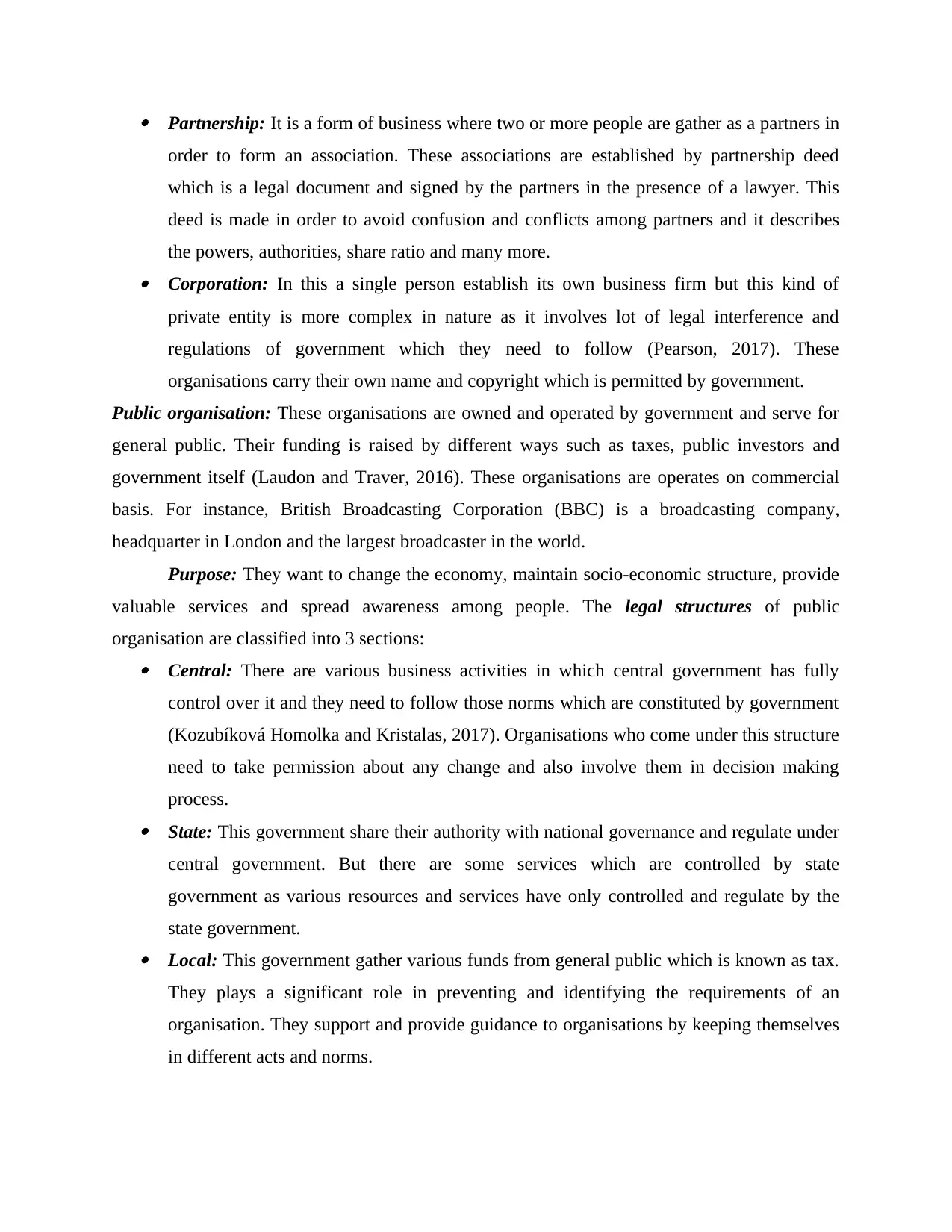
Partnership: It is a form of business where two or more people are gather as a partners in
order to form an association. These associations are established by partnership deed
which is a legal document and signed by the partners in the presence of a lawyer. This
deed is made in order to avoid confusion and conflicts among partners and it describes
the powers, authorities, share ratio and many more. Corporation: In this a single person establish its own business firm but this kind of
private entity is more complex in nature as it involves lot of legal interference and
regulations of government which they need to follow (Pearson, 2017). These
organisations carry their own name and copyright which is permitted by government.
Public organisation: These organisations are owned and operated by government and serve for
general public. Their funding is raised by different ways such as taxes, public investors and
government itself (Laudon and Traver, 2016). These organisations are operates on commercial
basis. For instance, British Broadcasting Corporation (BBC) is a broadcasting company,
headquarter in London and the largest broadcaster in the world.
Purpose: They want to change the economy, maintain socio-economic structure, provide
valuable services and spread awareness among people. The legal structures of public
organisation are classified into 3 sections: Central: There are various business activities in which central government has fully
control over it and they need to follow those norms which are constituted by government
(Kozubíková Homolka and Kristalas, 2017). Organisations who come under this structure
need to take permission about any change and also involve them in decision making
process. State: This government share their authority with national governance and regulate under
central government. But there are some services which are controlled by state
government as various resources and services have only controlled and regulate by the
state government. Local: This government gather various funds from general public which is known as tax.
They plays a significant role in preventing and identifying the requirements of an
organisation. They support and provide guidance to organisations by keeping themselves
in different acts and norms.
order to form an association. These associations are established by partnership deed
which is a legal document and signed by the partners in the presence of a lawyer. This
deed is made in order to avoid confusion and conflicts among partners and it describes
the powers, authorities, share ratio and many more. Corporation: In this a single person establish its own business firm but this kind of
private entity is more complex in nature as it involves lot of legal interference and
regulations of government which they need to follow (Pearson, 2017). These
organisations carry their own name and copyright which is permitted by government.
Public organisation: These organisations are owned and operated by government and serve for
general public. Their funding is raised by different ways such as taxes, public investors and
government itself (Laudon and Traver, 2016). These organisations are operates on commercial
basis. For instance, British Broadcasting Corporation (BBC) is a broadcasting company,
headquarter in London and the largest broadcaster in the world.
Purpose: They want to change the economy, maintain socio-economic structure, provide
valuable services and spread awareness among people. The legal structures of public
organisation are classified into 3 sections: Central: There are various business activities in which central government has fully
control over it and they need to follow those norms which are constituted by government
(Kozubíková Homolka and Kristalas, 2017). Organisations who come under this structure
need to take permission about any change and also involve them in decision making
process. State: This government share their authority with national governance and regulate under
central government. But there are some services which are controlled by state
government as various resources and services have only controlled and regulate by the
state government. Local: This government gather various funds from general public which is known as tax.
They plays a significant role in preventing and identifying the requirements of an
organisation. They support and provide guidance to organisations by keeping themselves
in different acts and norms.
Paraphrase This Document
Need a fresh take? Get an instant paraphrase of this document with our AI Paraphraser
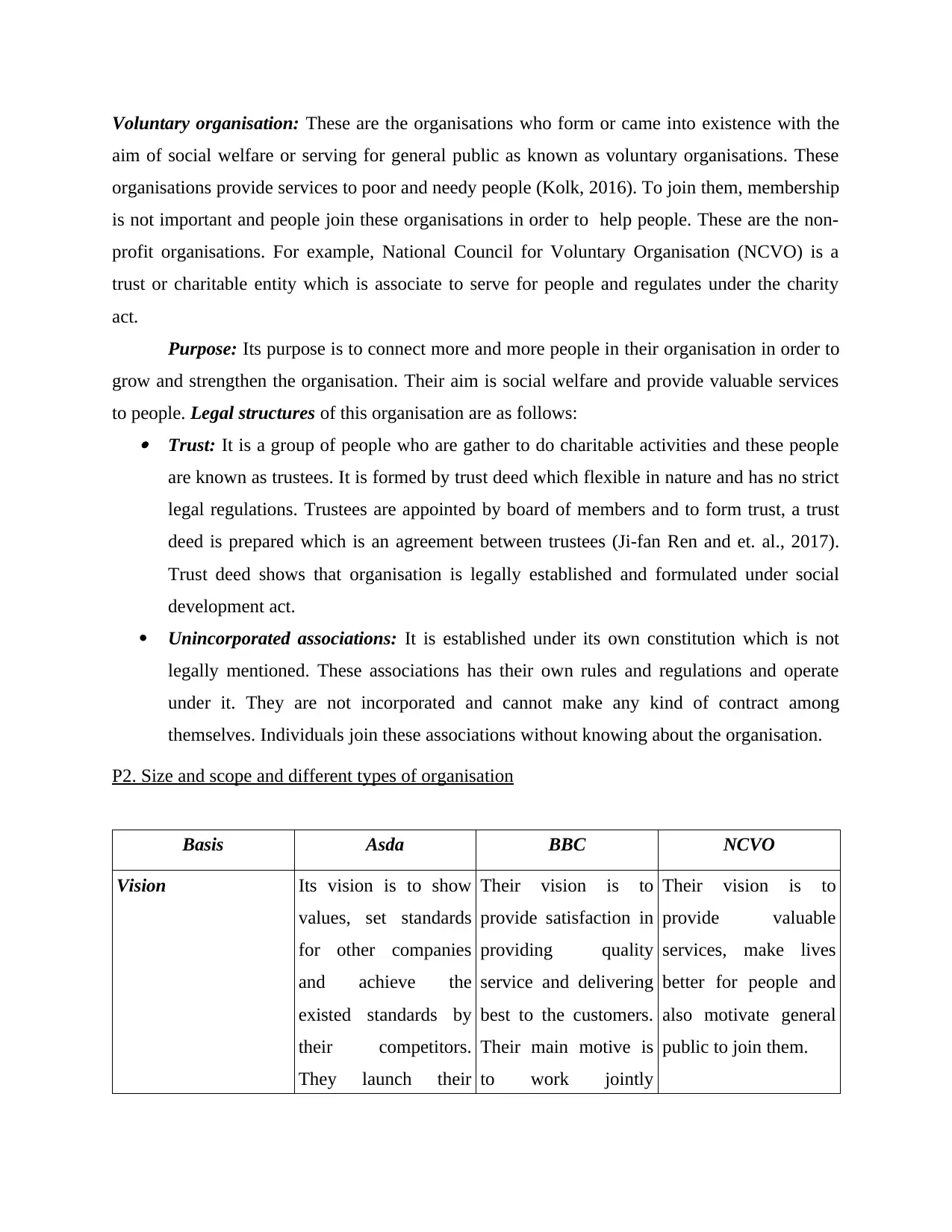
Voluntary organisation: These are the organisations who form or came into existence with the
aim of social welfare or serving for general public as known as voluntary organisations. These
organisations provide services to poor and needy people (Kolk, 2016). To join them, membership
is not important and people join these organisations in order to help people. These are the non-
profit organisations. For example, National Council for Voluntary Organisation (NCVO) is a
trust or charitable entity which is associate to serve for people and regulates under the charity
act.
Purpose: Its purpose is to connect more and more people in their organisation in order to
grow and strengthen the organisation. Their aim is social welfare and provide valuable services
to people. Legal structures of this organisation are as follows: Trust: It is a group of people who are gather to do charitable activities and these people
are known as trustees. It is formed by trust deed which flexible in nature and has no strict
legal regulations. Trustees are appointed by board of members and to form trust, a trust
deed is prepared which is an agreement between trustees (Ji-fan Ren and et. al., 2017).
Trust deed shows that organisation is legally established and formulated under social
development act.
Unincorporated associations: It is established under its own constitution which is not
legally mentioned. These associations has their own rules and regulations and operate
under it. They are not incorporated and cannot make any kind of contract among
themselves. Individuals join these associations without knowing about the organisation.
P2. Size and scope and different types of organisation
Basis Asda BBC NCVO
Vision Its vision is to show
values, set standards
for other companies
and achieve the
existed standards by
their competitors.
They launch their
Their vision is to
provide satisfaction in
providing quality
service and delivering
best to the customers.
Their main motive is
to work jointly
Their vision is to
provide valuable
services, make lives
better for people and
also motivate general
public to join them.
aim of social welfare or serving for general public as known as voluntary organisations. These
organisations provide services to poor and needy people (Kolk, 2016). To join them, membership
is not important and people join these organisations in order to help people. These are the non-
profit organisations. For example, National Council for Voluntary Organisation (NCVO) is a
trust or charitable entity which is associate to serve for people and regulates under the charity
act.
Purpose: Its purpose is to connect more and more people in their organisation in order to
grow and strengthen the organisation. Their aim is social welfare and provide valuable services
to people. Legal structures of this organisation are as follows: Trust: It is a group of people who are gather to do charitable activities and these people
are known as trustees. It is formed by trust deed which flexible in nature and has no strict
legal regulations. Trustees are appointed by board of members and to form trust, a trust
deed is prepared which is an agreement between trustees (Ji-fan Ren and et. al., 2017).
Trust deed shows that organisation is legally established and formulated under social
development act.
Unincorporated associations: It is established under its own constitution which is not
legally mentioned. These associations has their own rules and regulations and operate
under it. They are not incorporated and cannot make any kind of contract among
themselves. Individuals join these associations without knowing about the organisation.
P2. Size and scope and different types of organisation
Basis Asda BBC NCVO
Vision Its vision is to show
values, set standards
for other companies
and achieve the
existed standards by
their competitors.
They launch their
Their vision is to
provide satisfaction in
providing quality
service and delivering
best to the customers.
Their main motive is
to work jointly
Their vision is to
provide valuable
services, make lives
better for people and
also motivate general
public to join them.
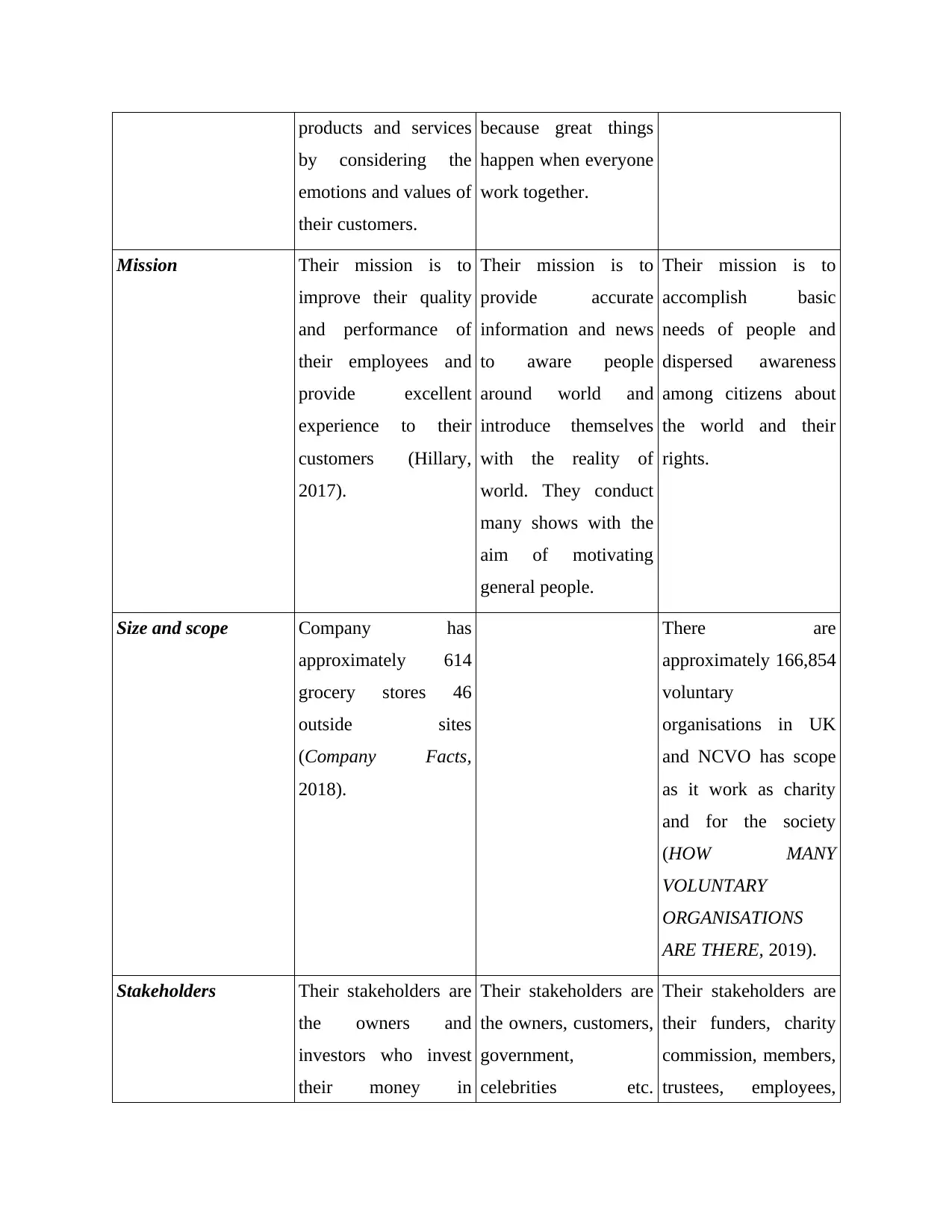
products and services
by considering the
emotions and values of
their customers.
because great things
happen when everyone
work together.
Mission Their mission is to
improve their quality
and performance of
their employees and
provide excellent
experience to their
customers (Hillary,
2017).
Their mission is to
provide accurate
information and news
to aware people
around world and
introduce themselves
with the reality of
world. They conduct
many shows with the
aim of motivating
general people.
Their mission is to
accomplish basic
needs of people and
dispersed awareness
among citizens about
the world and their
rights.
Size and scope Company has
approximately 614
grocery stores 46
outside sites
(Company Facts,
2018).
There are
approximately 166,854
voluntary
organisations in UK
and NCVO has scope
as it work as charity
and for the society
(HOW MANY
VOLUNTARY
ORGANISATIONS
ARE THERE, 2019).
Stakeholders Their stakeholders are
the owners and
investors who invest
their money in
Their stakeholders are
the owners, customers,
government,
celebrities etc.
Their stakeholders are
their funders, charity
commission, members,
trustees, employees,
by considering the
emotions and values of
their customers.
because great things
happen when everyone
work together.
Mission Their mission is to
improve their quality
and performance of
their employees and
provide excellent
experience to their
customers (Hillary,
2017).
Their mission is to
provide accurate
information and news
to aware people
around world and
introduce themselves
with the reality of
world. They conduct
many shows with the
aim of motivating
general people.
Their mission is to
accomplish basic
needs of people and
dispersed awareness
among citizens about
the world and their
rights.
Size and scope Company has
approximately 614
grocery stores 46
outside sites
(Company Facts,
2018).
There are
approximately 166,854
voluntary
organisations in UK
and NCVO has scope
as it work as charity
and for the society
(HOW MANY
VOLUNTARY
ORGANISATIONS
ARE THERE, 2019).
Stakeholders Their stakeholders are
the owners and
investors who invest
their money in
Their stakeholders are
the owners, customers,
government,
celebrities etc.
Their stakeholders are
their funders, charity
commission, members,
trustees, employees,
⊘ This is a preview!⊘
Do you want full access?
Subscribe today to unlock all pages.

Trusted by 1+ million students worldwide
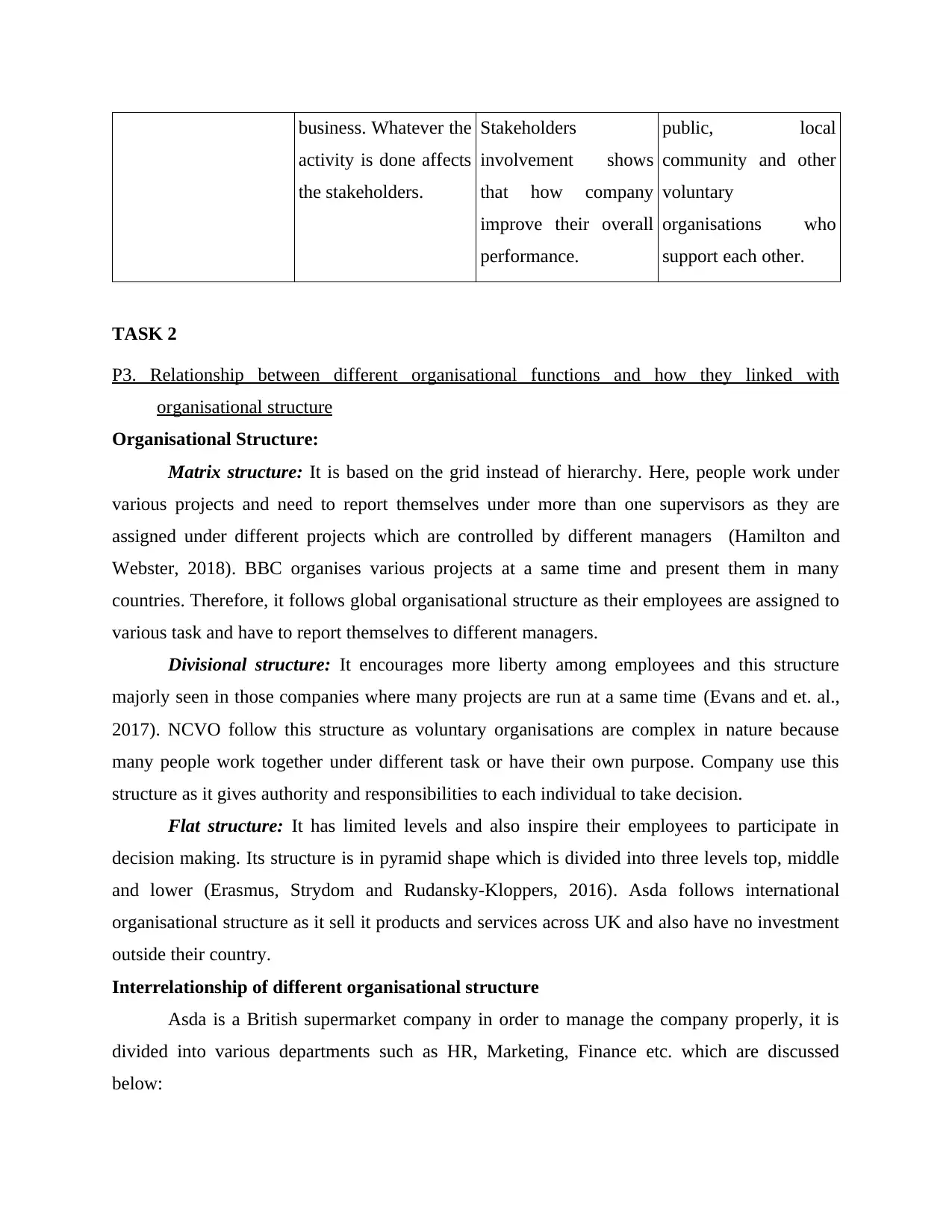
business. Whatever the
activity is done affects
the stakeholders.
Stakeholders
involvement shows
that how company
improve their overall
performance.
public, local
community and other
voluntary
organisations who
support each other.
TASK 2
P3. Relationship between different organisational functions and how they linked with
organisational structure
Organisational Structure:
Matrix structure: It is based on the grid instead of hierarchy. Here, people work under
various projects and need to report themselves under more than one supervisors as they are
assigned under different projects which are controlled by different managers (Hamilton and
Webster, 2018). BBC organises various projects at a same time and present them in many
countries. Therefore, it follows global organisational structure as their employees are assigned to
various task and have to report themselves to different managers.
Divisional structure: It encourages more liberty among employees and this structure
majorly seen in those companies where many projects are run at a same time (Evans and et. al.,
2017). NCVO follow this structure as voluntary organisations are complex in nature because
many people work together under different task or have their own purpose. Company use this
structure as it gives authority and responsibilities to each individual to take decision.
Flat structure: It has limited levels and also inspire their employees to participate in
decision making. Its structure is in pyramid shape which is divided into three levels top, middle
and lower (Erasmus, Strydom and Rudansky-Kloppers, 2016). Asda follows international
organisational structure as it sell it products and services across UK and also have no investment
outside their country.
Interrelationship of different organisational structure
Asda is a British supermarket company in order to manage the company properly, it is
divided into various departments such as HR, Marketing, Finance etc. which are discussed
below:
activity is done affects
the stakeholders.
Stakeholders
involvement shows
that how company
improve their overall
performance.
public, local
community and other
voluntary
organisations who
support each other.
TASK 2
P3. Relationship between different organisational functions and how they linked with
organisational structure
Organisational Structure:
Matrix structure: It is based on the grid instead of hierarchy. Here, people work under
various projects and need to report themselves under more than one supervisors as they are
assigned under different projects which are controlled by different managers (Hamilton and
Webster, 2018). BBC organises various projects at a same time and present them in many
countries. Therefore, it follows global organisational structure as their employees are assigned to
various task and have to report themselves to different managers.
Divisional structure: It encourages more liberty among employees and this structure
majorly seen in those companies where many projects are run at a same time (Evans and et. al.,
2017). NCVO follow this structure as voluntary organisations are complex in nature because
many people work together under different task or have their own purpose. Company use this
structure as it gives authority and responsibilities to each individual to take decision.
Flat structure: It has limited levels and also inspire their employees to participate in
decision making. Its structure is in pyramid shape which is divided into three levels top, middle
and lower (Erasmus, Strydom and Rudansky-Kloppers, 2016). Asda follows international
organisational structure as it sell it products and services across UK and also have no investment
outside their country.
Interrelationship of different organisational structure
Asda is a British supermarket company in order to manage the company properly, it is
divided into various departments such as HR, Marketing, Finance etc. which are discussed
below:
Paraphrase This Document
Need a fresh take? Get an instant paraphrase of this document with our AI Paraphraser
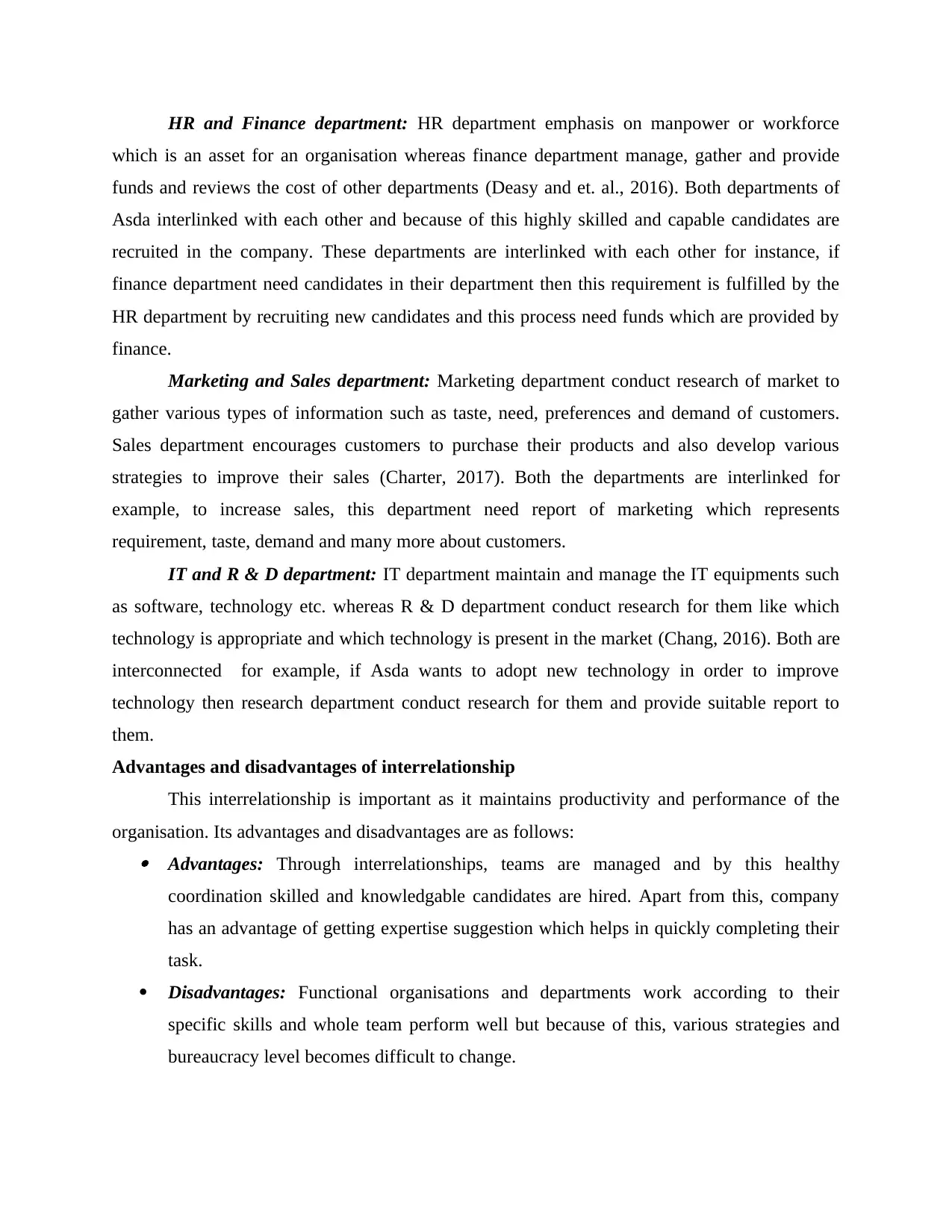
HR and Finance department: HR department emphasis on manpower or workforce
which is an asset for an organisation whereas finance department manage, gather and provide
funds and reviews the cost of other departments (Deasy and et. al., 2016). Both departments of
Asda interlinked with each other and because of this highly skilled and capable candidates are
recruited in the company. These departments are interlinked with each other for instance, if
finance department need candidates in their department then this requirement is fulfilled by the
HR department by recruiting new candidates and this process need funds which are provided by
finance.
Marketing and Sales department: Marketing department conduct research of market to
gather various types of information such as taste, need, preferences and demand of customers.
Sales department encourages customers to purchase their products and also develop various
strategies to improve their sales (Charter, 2017). Both the departments are interlinked for
example, to increase sales, this department need report of marketing which represents
requirement, taste, demand and many more about customers.
IT and R & D department: IT department maintain and manage the IT equipments such
as software, technology etc. whereas R & D department conduct research for them like which
technology is appropriate and which technology is present in the market (Chang, 2016). Both are
interconnected for example, if Asda wants to adopt new technology in order to improve
technology then research department conduct research for them and provide suitable report to
them.
Advantages and disadvantages of interrelationship
This interrelationship is important as it maintains productivity and performance of the
organisation. Its advantages and disadvantages are as follows: Advantages: Through interrelationships, teams are managed and by this healthy
coordination skilled and knowledgable candidates are hired. Apart from this, company
has an advantage of getting expertise suggestion which helps in quickly completing their
task.
Disadvantages: Functional organisations and departments work according to their
specific skills and whole team perform well but because of this, various strategies and
bureaucracy level becomes difficult to change.
which is an asset for an organisation whereas finance department manage, gather and provide
funds and reviews the cost of other departments (Deasy and et. al., 2016). Both departments of
Asda interlinked with each other and because of this highly skilled and capable candidates are
recruited in the company. These departments are interlinked with each other for instance, if
finance department need candidates in their department then this requirement is fulfilled by the
HR department by recruiting new candidates and this process need funds which are provided by
finance.
Marketing and Sales department: Marketing department conduct research of market to
gather various types of information such as taste, need, preferences and demand of customers.
Sales department encourages customers to purchase their products and also develop various
strategies to improve their sales (Charter, 2017). Both the departments are interlinked for
example, to increase sales, this department need report of marketing which represents
requirement, taste, demand and many more about customers.
IT and R & D department: IT department maintain and manage the IT equipments such
as software, technology etc. whereas R & D department conduct research for them like which
technology is appropriate and which technology is present in the market (Chang, 2016). Both are
interconnected for example, if Asda wants to adopt new technology in order to improve
technology then research department conduct research for them and provide suitable report to
them.
Advantages and disadvantages of interrelationship
This interrelationship is important as it maintains productivity and performance of the
organisation. Its advantages and disadvantages are as follows: Advantages: Through interrelationships, teams are managed and by this healthy
coordination skilled and knowledgable candidates are hired. Apart from this, company
has an advantage of getting expertise suggestion which helps in quickly completing their
task.
Disadvantages: Functional organisations and departments work according to their
specific skills and whole team perform well but because of this, various strategies and
bureaucracy level becomes difficult to change.
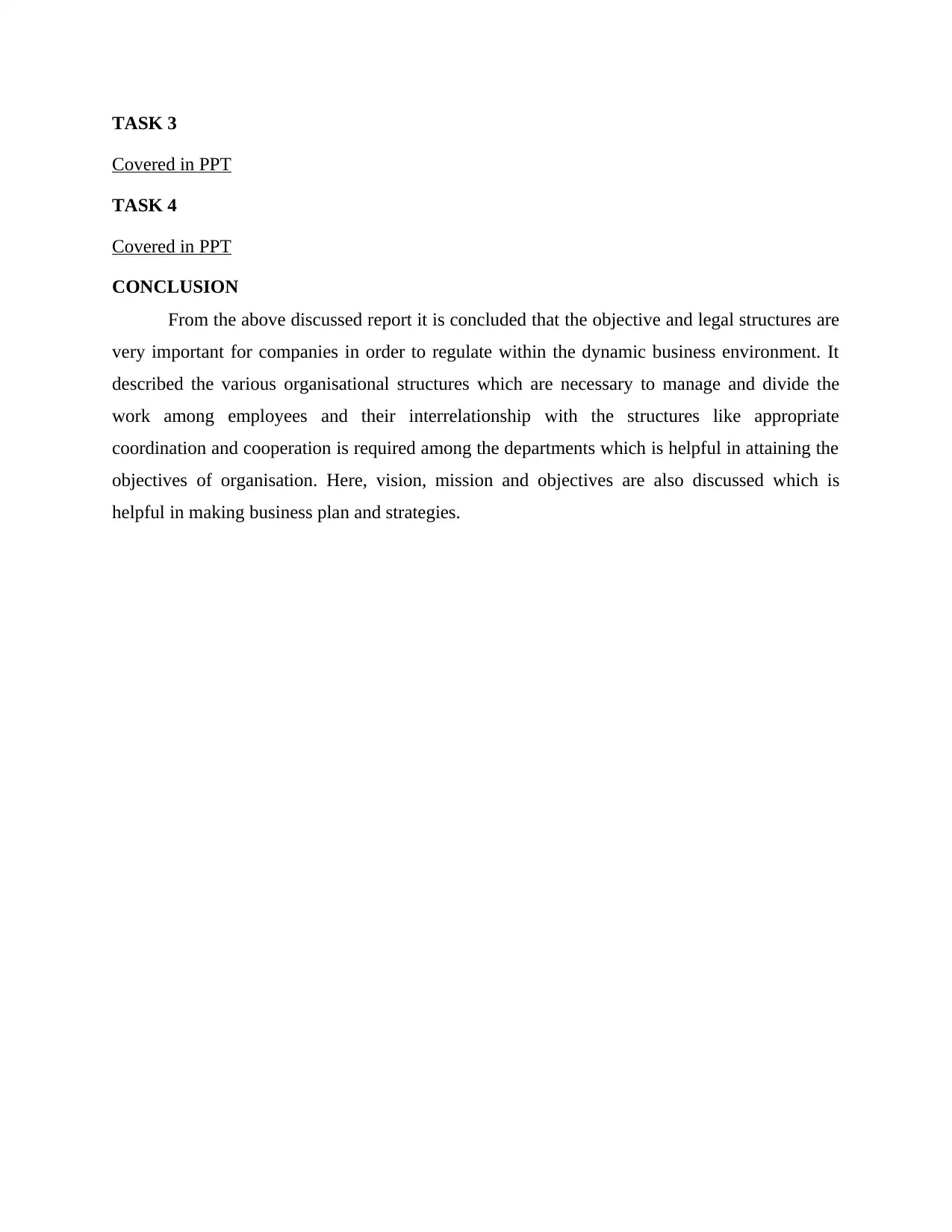
TASK 3
Covered in PPT
TASK 4
Covered in PPT
CONCLUSION
From the above discussed report it is concluded that the objective and legal structures are
very important for companies in order to regulate within the dynamic business environment. It
described the various organisational structures which are necessary to manage and divide the
work among employees and their interrelationship with the structures like appropriate
coordination and cooperation is required among the departments which is helpful in attaining the
objectives of organisation. Here, vision, mission and objectives are also discussed which is
helpful in making business plan and strategies.
Covered in PPT
TASK 4
Covered in PPT
CONCLUSION
From the above discussed report it is concluded that the objective and legal structures are
very important for companies in order to regulate within the dynamic business environment. It
described the various organisational structures which are necessary to manage and divide the
work among employees and their interrelationship with the structures like appropriate
coordination and cooperation is required among the departments which is helpful in attaining the
objectives of organisation. Here, vision, mission and objectives are also discussed which is
helpful in making business plan and strategies.
⊘ This is a preview!⊘
Do you want full access?
Subscribe today to unlock all pages.

Trusted by 1+ million students worldwide

REFERENCES
Books and Journal
Chang, J.F., 2016. Business process management systems: strategy and implementation.
Auerbach Publications.
Charter, M., 2017. Greener marketing: A responsible approach to business. Routledge.
Deasy, S., and et. al., 2016. Controlling use of a business environment on a mobile device. U.S.
Patent 9,247,042.
Erasmus, B., Strydom, J.W. and Rudansky-Kloppers, S. eds., 2016. Introduction to business
management. Oxford University Press Southern Africa.
Evans, S., and et. al., 2017. Business model innovation for sustainability: Towards a unified
perspective for creation of sustainable business models. Business Strategy and the
Environment. 26(5). pp.597-608.
Hamilton, L. and Webster, P., 2018. The international business environment. Oxford University
Press.
Hillary, R., 2017. Small and medium-sized enterprises and the environment: business
imperatives. Routledge.
Ji-fan Ren, S., and et. al., 2017. Modelling quality dynamics, business value and firm
performance in a big data analytics environment. International Journal of Production
Research. 55(17). pp.5011-5026.
Kolk, A., 2016. The social responsibility of international business: From ethics and the
environment to CSR and sustainable development. Journal of World Business. 51(1).
pp.23-34.
Kozubíková, L., Homolka, L. and Kristalas, D., 2017. The effect of business environment and
entrepreneurs’ gender on perception of financial risk in the smes sector. Journal of
Competitiveness.
Laudon, K.C. and Traver, C.G., 2016. E-commerce: business, technology, society.
Pearson, R., 2017. Business ethics as communication ethics: Public relations practice and the
idea of dialogue. In Public relations theory. (pp. 111-131). Routledge.
Prajogo, D.I., 2016. The strategic fit between innovation strategies and business environment in
delivering business performance. International Journal of Production Economics. 171.
pp.241-249.
Schaltegger, S., Hansen, E.G. and Lüdeke-Freund, F., 2016. Business models for sustainability:
Origins, present research, and future avenues.
Virglerová, Z., Dobeš, K. and Vojtovič, S., 2016. The perception of the state’s influence on its
business environment in the SMEs from Czech Republic. Administratie si Management
Public.
Online
Company Facts. 2018. [Online] Available through
<https://corporate.asda.com/our-story/company-facts>./
HOW MANY VOLUNTARY ORGANISATIONS ARE THERE. 2019 [Online] Available through
<https://data.ncvo.org.uk/profile/size-and-scope/>./
Books and Journal
Chang, J.F., 2016. Business process management systems: strategy and implementation.
Auerbach Publications.
Charter, M., 2017. Greener marketing: A responsible approach to business. Routledge.
Deasy, S., and et. al., 2016. Controlling use of a business environment on a mobile device. U.S.
Patent 9,247,042.
Erasmus, B., Strydom, J.W. and Rudansky-Kloppers, S. eds., 2016. Introduction to business
management. Oxford University Press Southern Africa.
Evans, S., and et. al., 2017. Business model innovation for sustainability: Towards a unified
perspective for creation of sustainable business models. Business Strategy and the
Environment. 26(5). pp.597-608.
Hamilton, L. and Webster, P., 2018. The international business environment. Oxford University
Press.
Hillary, R., 2017. Small and medium-sized enterprises and the environment: business
imperatives. Routledge.
Ji-fan Ren, S., and et. al., 2017. Modelling quality dynamics, business value and firm
performance in a big data analytics environment. International Journal of Production
Research. 55(17). pp.5011-5026.
Kolk, A., 2016. The social responsibility of international business: From ethics and the
environment to CSR and sustainable development. Journal of World Business. 51(1).
pp.23-34.
Kozubíková, L., Homolka, L. and Kristalas, D., 2017. The effect of business environment and
entrepreneurs’ gender on perception of financial risk in the smes sector. Journal of
Competitiveness.
Laudon, K.C. and Traver, C.G., 2016. E-commerce: business, technology, society.
Pearson, R., 2017. Business ethics as communication ethics: Public relations practice and the
idea of dialogue. In Public relations theory. (pp. 111-131). Routledge.
Prajogo, D.I., 2016. The strategic fit between innovation strategies and business environment in
delivering business performance. International Journal of Production Economics. 171.
pp.241-249.
Schaltegger, S., Hansen, E.G. and Lüdeke-Freund, F., 2016. Business models for sustainability:
Origins, present research, and future avenues.
Virglerová, Z., Dobeš, K. and Vojtovič, S., 2016. The perception of the state’s influence on its
business environment in the SMEs from Czech Republic. Administratie si Management
Public.
Online
Company Facts. 2018. [Online] Available through
<https://corporate.asda.com/our-story/company-facts>./
HOW MANY VOLUNTARY ORGANISATIONS ARE THERE. 2019 [Online] Available through
<https://data.ncvo.org.uk/profile/size-and-scope/>./
Paraphrase This Document
Need a fresh take? Get an instant paraphrase of this document with our AI Paraphraser

1 out of 11
Related Documents
Your All-in-One AI-Powered Toolkit for Academic Success.
+13062052269
info@desklib.com
Available 24*7 on WhatsApp / Email
![[object Object]](/_next/static/media/star-bottom.7253800d.svg)
Unlock your academic potential
Copyright © 2020–2025 A2Z Services. All Rights Reserved. Developed and managed by ZUCOL.





![Business and the Business Environment: Report for [University Name]](/_next/image/?url=https%3A%2F%2Fdesklib.com%2Fmedia%2Fimages%2Fbe%2F38fa8050ce8f491d8760aff1b89116bc.jpg&w=256&q=75)